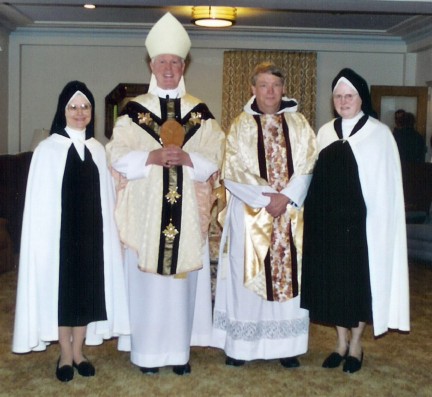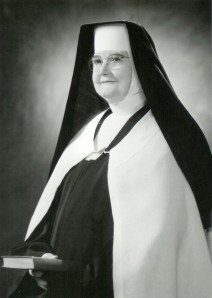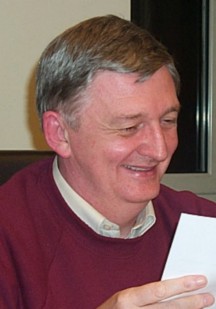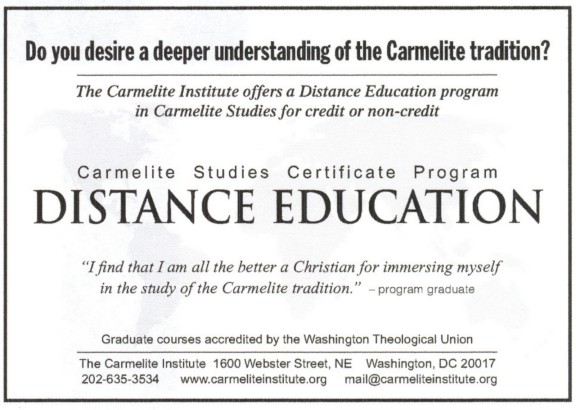|
no. 1 january - march 2004 THE CARMELITE SISTERS FOR THE AGED AND INFIRM CELEBRATE 75TH ANNIVERSARY
(Above - Left to Right): Mother Mary Suzanne, O.Carm., Superior General, Carmelite Sisters for the Aged and Infirm, Bishop James C. Timlin, DD (former Bishop of Scranton, Pennsylvania), Very Rev. Michael Kissane, O.Carm. (Prior Provincial, North American Province of St. Elias), and Sister M. Michael Rosarie, O.Carm. (a former Superior General, first to succeed Mother M. Angeline Teresa as Superior General) following a Mass in New York celebrating the 20th Anniversary of Mother Angeline Teresa’s entrance into heaven on January 21, 2004. (Right) Mother M. Angeline Teresa. (Photo courtesy of the Carmelite Sisters for the Aged and Infirm) O n September 3rd of this year, the Carmelite Sisters for the Aged and Infirm will mark 75 years since their Congregation was founded in New York City by the Servant of God, Mother Mary Angeline Teresa McCrory, O. Carm.Mother Angeline, born in Co. Tyrone, Ireland, was a woman ahead of her time. While still in her teens, she entered the Congregation of the Little Sisters of the Poor. After her initial training in France, she was assigned to the Home of the Little Sisters in Brooklyn, New York. Although having a great love for her Congregation, Mother Angeline had a growing sense of the need to adapt the care of the elderly to the American culture with its varied, meaningful customs and less restrictive ways. She also saw the need to provide care for the elderly of all economic classes, not just the destitute aged. Moved by the spirit of Hospitality which she vowed as a Little Sister, Mother Angeline envisioned homelike residences that would reflect a spirit of warmth, welcome and the freedom to enjoy life to its fullest during the later years. And so it was in 1929, the year of the Great Depression, that Mother Angeline Teresa approached New York’s great "Cardinal of Charity," Patrick Cardinal Hayes, and explained her desires to him. The Cardinal recognized that Mother’s solicitude for the aged of all classes was a divine inspiration and a great need in the Archdiocese. Since such work could not be conducted within the existing structure of the Little Sisters, the Cardinal told Mother Angeline that it might be necessary to start out on her own. He reassured her: "If this be the work of God, it will prosper." Thus it came about that Mother Angeline and her six companions, all
former Little Sisters, embraced the challenge God set before them. They
moved into what was St. Elizabeth’s Rectory on Broadway in New Yark City.
Their first guests were seven elderly people who helped with chores around
the household and enjoyed a real sense of "family" under the loving care
of the Sisters. God rewarded Mother Angeline’s trust by allowing her to
sow the seeds of her vision in many other parts of the United States and
even back in her native Ireland. He gave her successors to carry on the
important work she began. Today, Carmelite Sisters number over 200 On her 91st Birthday - January 21, 1984 - God called Mother Angeline to her heavenly reward. In 1985, the Promotion of the Cause of Mother Angeline was begun, and in June of 1989, Mother Angeline was declared: Servant of God It is hoped that one day she will join the ranks of the blesseds and ultimately be among the saints of Carmel, giving final glory to God not only by her lifetime’s works, but mare importantly, by her lifetime of holiness. For more information on the Carmelite Sisters for the Aged and Infirm or the Cause of Mother M Angeline Teresa, contact: Mother Mary Suzanne, O.Carm., 600 Woods Rd, Germantown, New York 12526, USA. Telephone: 518-537-5000. Fax: 518-537-5226. Titus Brandsma "In Vision and Sound" in Permanent Exhibition
The reconstructed prison cell of Titus Brandsma from Scheveningen prison which Brandsma so aptly depicted in his last work ‘My Cell’ (Photo courtesy of the Titus Brandsma Museum)
The museum has been functioning since May 2003. Though the museum began as a Catholic archive, it has moved towards displaying the spirituality and inspiration for today of the little, beatified Carmelite in the format of a museum. There are many connections between Titus Brandsma and the modern world. Some organizations exist which were founded by Brandsma. An international award, lectures and courses all carry the Brandsma name. Modern struggles for emancipation are influenced by Brandsma. The exhibition of Titus Brandsma’s life and works fills the whole ground floor of the museum. The exhibition, "Here I Stand, This Is My Vocation" primarily offers a broad overview of the life of Titus Brandsma (1881–1942). Various aspects of Titus’ life in Dutch society, from his Frisian roots until his imprisonment in a German concentration camp, are grouped around a source of Titus’ spirituality: the cell. Replicas of Titus’ cell in the Boxmeer cloister and his prison cell in Scheveningen have been built in the museum. Prayer, contemplation, and reflection in his cell became the source of strength that gave Titus new energy and direction for his many diverse activities, including his resistance against the Nazi oppression. Besides displaying some of the well-known as well as lesser known pictures of Brandsma, the museum also contains some personal clothes and effects of Titus that never been displayed in public. There are also letters, poems, and books by Brandsma and some of his collected copies of medieval manuscripts by famous mystical writers like Gerard Groote, Hadewijch, Teresa of Avila and Ruusbroec. A unique offering are the original voice recordings of Titus Brandsma. Not only can one listen to Brandsma’s famous speech on the Dutch Catholic press, but the exhibition also contains a formerly unknown recording of Brandsma using his native Frisian language. The exhibition ends with a representation of Brandsma’s martyrdom which displays the Stations of the Cross created by the Flemish artist Albert Servaes in 1921. That work was reviled at the time by the Vatican reviled but defended by Titus Brandsma. Equally controversial is the portrait that Dutch artist and Nazi-supporter Pyke Koch made of Titus Brandsma in the 1960’s. Such exhibits demonstrate the desire of the Titus Brandsma Museum to illustrate the wide response that Brandsma’s life continues to elicit, including from unexpected quarters.
I was invited to open the Titus Brandsma Museum in Bolsward, Netherlands, on the 24 th January 2004. I stayed in Almelo, the Provincial house, about a two-hour car journey from Bolsward. The event took place in the parish church beside the museum and there were about 200 invited guests present.The opening speech was given by Mr. Tjebbe de Jong, the chairman of the foundation for the Titus Brandsma Museum. He welcomed everyone and gave a brief history of the project, which has been in planning for over four years. Everyone was asked to step outside briefly where I pulled down the curtain to reveal a new sign for the museum and thus signifying the formal opening. We then returned to the church where I gave a speech on the spiritual significance of Titus. I was followed by Mr. Nijpels, the Royal Commissioner for the Province of Friesland, who spoke on the significance of Blessed Titus for Friesian culture and language. As a politician, he surprisingly had a strong religious tone to his speech. As a Catholic, he clearly empathised with his subject matter and he finished his speech by quoting the famous poem of Titus written in his prison cell. Next to speak was Mgr. Eijk, the bishop of Groningen, to whose diocese Bolsward belongs. The final speaker was Mrs. Vroegindeweij, the mayor of the city of Bolsward. After the speeches, we were escorted around the museum. Due to the number of people, it was not possible to spend much time there, however, it was sufficient to get the impression of a very well planned lay out. Titus is examined from various perspectives: Carmelite, intellectual, journalistic, his importance for the Netherlands and for Friesland in particular. There are two cells in the museum: one representing his room in his monastery and the other in his first prison cell in Scheveningen. The museum is small but there is room for some growth and the committee is full of ideas and plans. It is well worth a visit. The following day I paid a visit to the brothers and nuns in Zenderen. Joseph Chalmers O.Carm.
|
|
|
RETURN TO THE INDEX FOR 2004 | RETURN TO THE INDEX FOR THIS ISSUE INDEX OF CARMELITE
WEBSITES |




